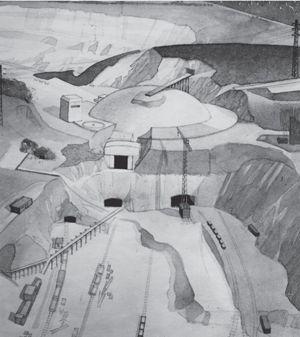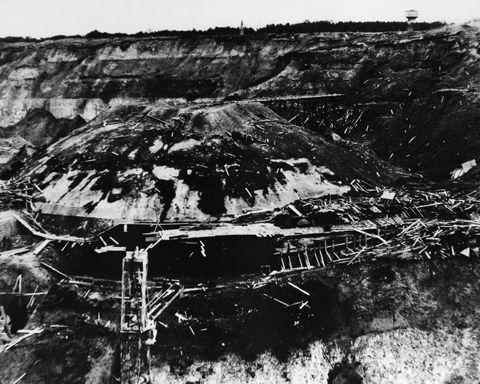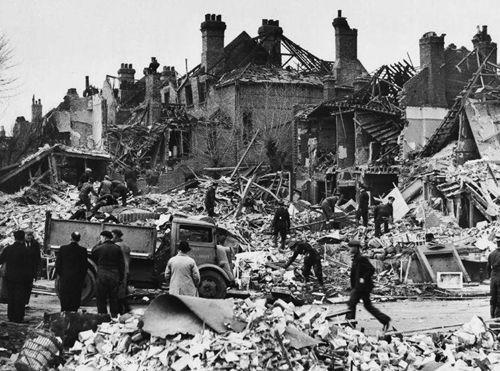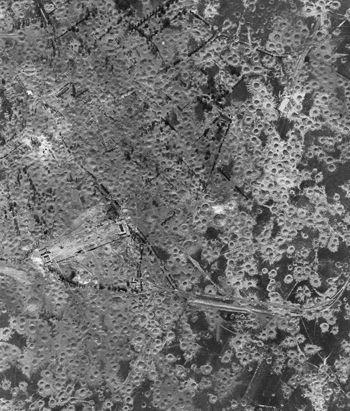Women of Intelligence: Winning the Second World War with Air Photos (41 page)
Read Women of Intelligence: Winning the Second World War with Air Photos Online
Authors: Christine Halsall

A V-2 missile firing in 1944.
General Eisenhower, supreme commander of the invasion, later commented:
It seemed likely that, if the enemy had succeeded in perfecting and using these new weapons six months earlier than he did, our invasion of Europe would have proved exceedingly difficult, perhaps impossible. I feel sure that if he had succeeded in using these weapons over a six month period, and particularly if he had made the Portsmouth – Southampton area one of his principal targets, Overlord (the Normandy Landings) might have been written off.
12
Two years after joining the D-Day planning team in 1942, on another summer’s day in London, Ursula Powys-Lybbe had first-hand experience of a Doodlebug:
I had no sensation of noise, which seemed most peculiar as the flying bomb had driven itself into the roof immediately above us and exploded – all I was aware of was a swaying movement around me, dust rising everywhere, and a feeling of utter desolation and disorientation as many of the dividing walls had collapsed. I turned round to see what had happened to my friends and was horrified to be faced with a pile of rubble blocking the passage between us from floor to ceiling. Five of our personnel had been killed and several injured, as I learnt later. I was too stunned to move, and too stunned to answer the many questions plied to me by a group of air raid wardens and ambulance men who had materialised from a staircase which I never knew existed until the door had been blown off. One of the rescuers handed me an American officer’s raincoat, and pushing me towards the staircase, said kindly, ‘You’re not needed here, love, get on your way home,’ and I found myself walking towards Berkeley Square with the rain still pouring down.
Suddenly I was stopped by a young Naval officer, RNVR, brandishing a piece of sodden paper. It had TOP SECRET written all over it and he asked me, ‘Does this belong to you by any chance? It came floating down from somewhere.’ I replied with something unintelligible and he looked at me closely. ‘You look as if you need salvaging, come with me,’ and taking my arm led me towards Charles Street. We came to the American Officers’ Club of which he was a member, and where I had once disgraced myself by mistaking peanut butter for mustard.
My new friend addressed himself to a very elegant receptionist who was eyeing me with obvious disapproval. ‘Is there anywhere for this officer (meaning me) to clean herself up?’ he asked. My uniform was concealed under the raincoat filthy with plaster and brickdust, my hair also filthy, with streaks of the stuff all over my face and hands – I was a mess.

A perspective view of the entrance to the V-2 launch site at Wizernes, in north-east France, drawn in early 1944. It was prepared by the Wild Section, entirely from air photographs, and was subsequently proved to be accurate in all respects.

The V-2 site at Wizernes was built in a quarry. To obtain this daring low-level oblique, the PR pilot flew down into the quarry, pulling steeply away once the photograph had been taken. The site was extensively bombed in 1944 and rendered inoperable.

Damage caused by a V-2 falling in Hornsey, North London.
The elegant receptionist now stared at me with obvious distaste, and being English, behaved as if she were totally unaware of the mayhem that had been created just down the street. ‘Are you a member?’ she enquired loftily.
13
On
9
September 1944 the Air Ministry News Service issued a bulletin:
Thousands of WAAF personnel – Air Ministry Staff officers, photographic interpretation officers, photographers and plotters – the WAAF of Air Defence Great Britain (ADGB), RAF Bomber Command and Balloon Command, have played an important part in the flying bomb battle since it began eighteen months ago.
One of the ‘expert interpreters’ mentioned recently by Mr Duncan Sandys MP was Flight Officer Babington Smith. She was the first to notice unusual features in the photographs taken at Peenemunde in May 1943, and later was responsible for drawing the attention of the Intelligence authorities to the speck of a miniature aircraft which was eventually proved to be a flying bomb. In the ensuing months she and her section examined many thousands of photographs, not only of Peenemunde but of all possible localities for flying bomb sites and the factories that might be used for manufacturing and assembling the new weapon.
In the words of an RAF officer at her photographic interpretation unit: ‘These girls have done a fine job and have played a vital part in warning us of the enemy’s intentions. If it hadn’t been for their accurate and thorough work much valuable information might have been missed.’
Throughout the winter months when the reconnaissance pilots brought back their pictures of flying bomb bases on the French coast, hundreds of WAAF photographers who process the films were hard at work night and day developing, drying and printing photographs ready to be rushed to the interpretation experts for scrutiny. They were not dealing exclusively with flying bomb material but during all these pre-invasion months handled as many as 50,000 prints a day, including aerial pictures of the landing beaches, many coastal batteries, railway junctions, troop and freight concentrations. All this time a specially selected handful of WAAF officers were working at the Air Ministry assisting in planning counter-measures against the new menace.
And when, a few days after D-Day, the long expected flying bombs were launched, WAAF plotters of ADGB tracked on wall and table maps throughout south-east England the height and direction of the new weapon so that accurate information could be relayed to the fighter pilots to guide them to the attack.
14

The post-raid photographs of the V-3 site at Mimoyecques, northern France, on 6 July 1944 showed that, despite extensive bombing, the target had not been destroyed. A further raid would be mounted using heavier bombs.
Douglas Kendal wrote:
The flying bombs killed 6,184 people in London and seriously injured about 18,000. The number of houses damaged was about 750,000. In addition 2,000 British, American and Canadian airmen lost their lives in the counter offensive. The enemy achieved an average of just under 100 launchings in every 24 hour period, or about one every fifteen minutes, day and night.
In all 1,190 V2 rockets reached England, of which about 500 reached the London area, killing 2,724 people and injuring 6,467, a far higher percentage than the V-1.
15
The chilling reality was that more secret weapons were on the drawing board to follow the V-1 and the V-2. The V-3 was near to completion and successors were planned to follow.
Notes
1
. Powys-Lybbe, Ursula,
Eye of Intelligence
, p.129.
2
. Searle, Adrian,
PLUTO: Pipe Line Under The Ocean
(Shanklin Chine, 2004), p.52.
3
. Grierson, Mary ‘Bunny’, letter about D-Day (Medmenham Collection).
4
. The Pegasus Bridge model, with others, may be seen in the Airborne Forces’ Museum at the Imperial War Museum, Duxford.
5
. An audio recording of Miss Mary Harrison, held by the Department of Documents at the Imperial War Museum, 2001.
6
. Windsor, Lucia, conversation with the author, 2003.
7
. O’Neil (
née
Peat), Pat, audio recording.
8
. Horne (
née
Macalister), Elspeth, memoirs.
9
. Sowry (
née
Adams), Jeanne, article in
The Times
,
5 June 2009.
10
. Brisley-Wilson (
née
Howie), Pamela, IWM papers.
11
. Harrison Mary, IWM papers.
12
. From President Eisenhower’s book,
Crusade in Europe
, 1948, quoted in Douglas Kendall’s unpublished account, ‘A War of Intelligence’ (Medmenham Collection).
13
. Powys-Lybbe, Ursula,
The Eye of Intelligence
,
pp.207–8.
14
.Air Ministry Bulletin No. 15560 issued on 9 September 1944.
15
. Kendall, Douglas, ‘A War of Intelligence’.
ND
T
HEN IT WAS
A
LL
O
VER
As the war entered its final year in 1945 the work at Medmenham continued unabated. The identification of the transportation routes and storage sites for the V-2 rockets was ongoing, as was the preparation of target material for the bombing raids on Germany’s last lines of defence and supply centres. The attacks on synthetic oil factories and underground aircraft assembly plants were of particular relevance to the Allied advance towards Berlin as they minimised the number of aircraft the Luftwaffe could fly. As more male personnel were detached from Medmenham to posts in Europe, where they used their PI for tactical purposes, their places were filled by women. At the end of March 1945 WAAF numbers at Medmenham slightly outnumbered those of the RAF: 684 RAF and 719 WAAF. The overall numbers of personnel for army, navy and air force, including American forces, at Medmenham were 908 men and 794 women. The largest single service group was the WAAF.